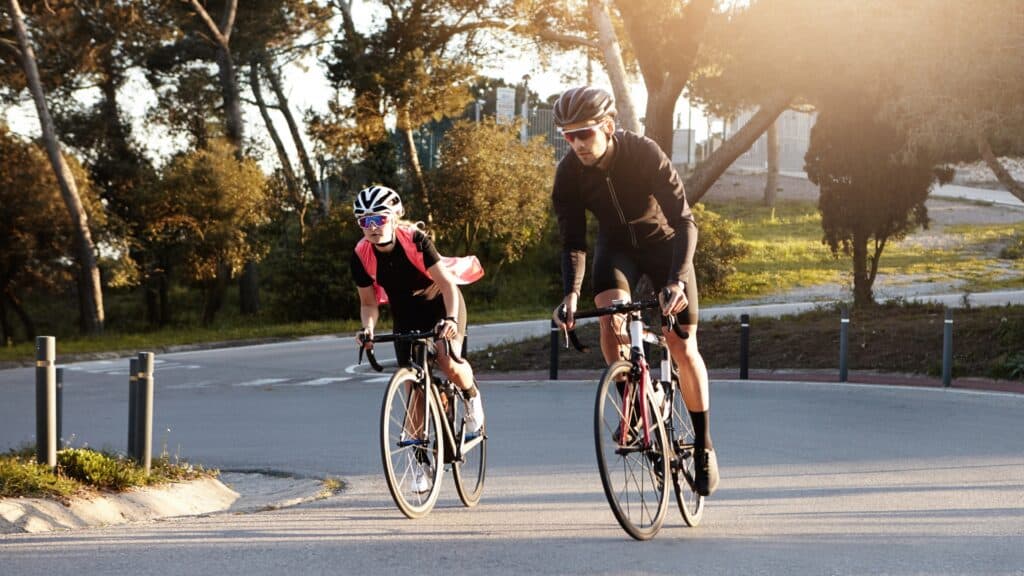Navigating water bridges & switchbacks on a bike can be a daunting challenge for many cyclists, especially when they are faced with the unique technical and mental aspects these bridges present.

Understanding the Challenge Of Water Bridges
Water bridges, often encountered in races like the Old Mutual joBerg2c, can intimidate even seasoned riders.
The key to overcoming this challenge lies more in mental preparedness than physical skill. Many cyclists psych themselves out before even reaching the bridge, leading to unnecessary anxiety and hesitation.
Key Strategies for Navigating Water Bridges
1. Maintain Speed and Momentum
- Consistent Speed: It’s crucial to maintain a consistent speed as you approach and ride over the bridge. This helps in maintaining balance and control.
- Gaps Between Riders: Leave a sufficient gap between yourself and the rider ahead. This precaution ensures you have enough space to maneuver in case the rider in front stops or slows down unexpectedly.
2. Trust Your Skills
- Confidence is Key: Trust in your abilities and skills. The bridges are designed to be ridden over and won’t necessarily throw you off unless you overthink the process.
- Practice Makes Perfect: Like any technical skill, riding over water bridges gets easier with practice. The more you do it, the more comfortable and confident you’ll become.
3. Gear Selection
- Appropriate Gear: Select the right gear before entering the bridge. You don’t want to be in too low a gear, causing you to spin out, nor in too high a gear, making it hard to pedal and maintain momentum.
- Avoid Gear Changes on the Bridge: Trying to shift gears while on the bridge can disrupt your balance and momentum, so choose your gear beforehand.
4. Look Ahead
- Anticipate Turns and Bends: Keep your eyes focused 10-15 meters ahead to anticipate any bends or turns in the bridge. This forward-looking approach helps in making smooth adjustments without sudden movements.
- Stay Relaxed: Keep a relaxed posture. Tension can lead to overcorrection and imbalance.
Riding over water bridges should be seen as an enjoyable part of the cycling experience rather than a hurdle.
Even if you do end up taking an unexpected swim, it’s not the end of the world. Such experiences contribute to your growth as a cyclist.
Water bridges can indeed be tricky, but with the right approach and mindset, they can also be a fun and rewarding part of your ride. By maintaining a consistent speed, trusting your skills, choosing the appropriate gear, and looking ahead, you can confidently tackle these bridges. Remember, practice in training is crucial to prepare for race day.
For more tips and structured cycling training programs, visit the Coach Parry Training Platform.
Whether you’re preparing for your first race or looking to improve your technical skills, the platform offers a variety of programs and access to experienced coaches to help you achieve your cycling goals.

Mastering Switchbacks: Tips for Cyclists
Switchbacks can be a challenging part of any cycling route, especially in demanding races like the Old Mutual joBerg2c.
By following these tips, you can enhance your confidence and performance on these tricky sections.
Key Strategies for Riding Switchbacks
1. Ride More Switchbacks
- Practice Makes Perfect: The best way to improve your switchback skills is to ride more of them. Look for routes that include switchbacks or consider joining skills clinics to get professional guidance and practice.
2. Handling Uphill Switchbacks
- Shift Your Weight: To prevent your front wheel from lifting, shift your weight slightly forward over the front wheel. This helps maintain traction and control.
- Maintain a Consistent Cadence: Keep a comfortable and steady cadence to ensure you maintain momentum. Avoid putting too much pressure on the handlebars, which can cause you to lose your line if you hit an obstacle.
3. Handling Downhill Switchbacks
- Shift Your Weight Back: For tight downhill switchbacks, move your weight backward to prevent going over the front of the bike.
- Look Ahead: Focus on looking through the turn and where you want to exit. Use your head and hips to guide the bike in the desired direction.
- Lead with Your Head: Your head plays a crucial role in guiding the bike. By leading with your head, you can steer more effectively through the turn.
Confidence and Exposure
1. Build Confidence in Your Skills
- Trust Your Abilities: Be confident in the skills you have. The more you practice, the more comfortable you’ll become with switchbacks.
- Exposure is Key: Get as much exposure as possible to different switchback conditions. This will help you adapt to various scenarios you might encounter during a race.
2. Focus on Yourself
- Avoid Pressure from Other Riders: In races, you might feel pressure from other riders behind you. Focus on your own ride and avoid taking unnecessary risks due to external pressure.
Improving your switchback skills is a combination of practice, confidence, and technical know-how. By regularly practicing on routes with switchbacks, adjusting your weight distribution, maintaining a consistent cadence, and looking ahead through turns, you can significantly enhance your ability to handle these challenging sections.
Remember to focus on your own ride and gradually build your confidence through exposure and experience.



Comments are closed.